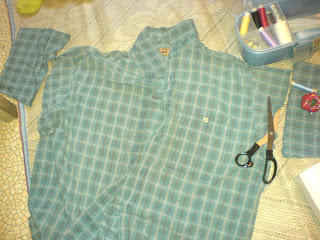One of my earliest fascinations with handiwork include ships-in-bottles being offered by merchants who go around town selling "door-to-door". They sell their merchandise by going from one household to another.
As far as I could remember, most of the time these merchants were ex-cons or ex-offenders who were either doing that trade for a living (as we may know, there aren't too many options for them) or were part of program wherein they help raise funds for offenders who are still inside prison. I recall some neighbors who bought these ships-in-bottles to help the inmates/ex-cons rather than out of pure interest in the items.
In my childhood I thought that only inmates were the ones who produced ships-in-a-bottle. Of course I've learned a long time ago that the craft is made countrywide (and worldwide) but up to this day I'm still enchanted whenever I see one.
Every kid (and even adults) would say "How did it get in there?". I used to believe the ship was some kind of balloon that expands whenever it got inside the bottle. That would be very easy right?
In truth, according to David S. Smith in his article
How the Ship Gets in the Bottle..., "the work is extremely tedious and labor intensive. There are no shortcuts. I must painstakingly craft each separate piece of the model to the correct scale - never mind having to place them through the neck into the bottle afterwards, and working with 'mechanical fingers' eight inches (or more) away from my hands."
In the Philippines, I was able to find a wide selection of ships-in-a-bottle manufactured by
Tigaon Handicraft based in Tigaon, Camarines Sur, Bicol region (I spent half of my childhood in this region, but in another province though!).
They offer miniature, medium, and large-size ships-in-bottles. There are even wedding souvenirs/give-aways (if you attend a Filipino wedding, you'll get a souvenir). Here are the samples:
(*Items are all handmade and inserted through the bottleneck. 'Ships' fixed at the glassputty "ocean" and item can be easily transported. The cork is sealed with real sealing-wax.)
Miniature:
Miniature SEUTE DEERN 50 cc (7.2x4.5 cm). approx. US $3.00

Miniature SANTA MARIA 50 cc (7.2x4.5 cm). approx. US $3.00
Medium:
Medium PASSAT 375 cc flat Lapad Bottle (21x9 cm). approx. US $12.00

Medium Whaler CHARLES W. MORGAN (Moby Dick) 375 cc square Gilbeys Gin Bottle (19x8 cm). approx US $16.00
This Ship-in-Bottle is constructed in the so-called "perfect hair system." (PHS) All the " strings" of the rig are made of real animal and human hair. The model is first built and completely finished outside the bottle. Then, each mast, including sails etc., is removed again. After that the hull is inserted into the bottle. Then each mast is individually added and all is glued into place.
This technique makes it possible to reproduce fine details because pressure on the rig is minimal and more delicate materials can be used. Also the hull and superstructure can be larger since they take up the entire diameter of the bottle neck. Building models in this technique is rather time consuming and requires great skill. This explains the difference in price as compared to models of traditional design.
Large:
RICKMER RICKMERS 1 Gallone Bottle (33x16 cm). approx US $63.00
Wedding souvenir:
*photos and item information taken from
Tigaon Handicraft.



























